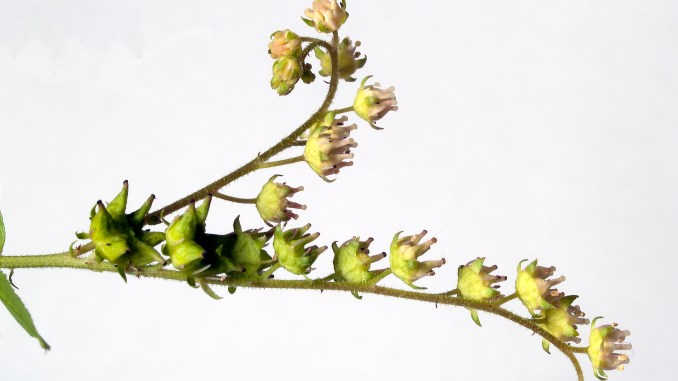
A marginal pond plant from North America, with pretty red fruits and autumn foliage.
Penthorum sedoides is a perennial herb native to the eastern United States where it grows in wet soils or shallow water on river banks, marshes, ditches and the margins of pools. Plants from this part of the world were some of the first non-European plants to be grown in UK gardens, as seeds and specimens were sent to keen English gardeners and botanists such as Peter Collinson from their counterparts in the eastern American colonies such as John Clayton and Mark Catesby in Virginia and John Bartram in Pennsylvania.

Linnaeus named the species in 1753 based on specimens sent by Clayton, and by 1768 it was growing at the Chelsea Physic Garden where the head gardener Philip Miller was a little sniffy about it in his Gardener’s Dictionary:
“As this plant makes a mean appearance, so it is rarely cultivated, except in botanic gardens for the sake of variety”.
It is true that the species is of botanical interest. Although morphologically it seemed to bear some affinity with sedums, botanists disagreed as to how it should be classified right up until very recently, when molecular evidence confirmed that it should be placed in its own family, named Penthoraceae, along with only one other species (found in China) P. chinensis. The family is now considered to be sister to Haloragaceae in the Saxifragales order.

I think Miller was wrong, however, to describe the appearance as “mean”. The flowers are certainly nondescript, though the slight spiral-curl to the tips of the flower spikes is charming. The dull flowers are more than made up for though by the distinctive star-shaped fruits, which turn bright red when ripe, as do the leaves in autumn. In our garden, we grow it in a pot on the edge of our tiny pond, along with fellow North American aquatic Anemopsis californica.


This is an undemanding plant which deserves a place on the edge of any garden pond, perhaps as a foil to its flashier cousins.

Anemopsis distribution
Countries where Penthorum sedoides grows in the wild.


Interesting – a new plant to me. Thanks for all the back ground information!
Interesting plant! I like wildflowers
Have a wonderful week!
Thanks for introducing such beautiful plant .